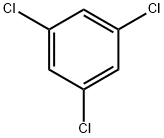A7672312
1,3,5-Trichlorobenzene solution , analyticalstandard,0.100mg/mlinisooctane , 108-70-3
CAS NO.:108-70-3
Empirical Formula: C6H3Cl3
Molecular Weight: 181.45
MDL number: MFCD00000585
EINECS: 203-608-6
Update time: 2022-07-08
PRODUCT Properties
| Melting point: | 63 °C |
| Boiling point: | 208 °C(lit.) |
| Density | 1.4528 (estimate) |
| vapor pressure | 0.58 at 25 °C (quoted, Mackay et al., 1982) |
| refractive index | 1.5693 (estimate) |
| Flash point: | 260 °F |
| storage temp. | 0-6°C |
| solubility | Soluble in benzene, ether, ligroin (Weast, 1986), glacial acetic acid, carbon disulfide, and
petroleum ether (Windholz et al., 1983) |
| form | powder or crystals |
| color | Off-White |
| Water Solubility | Insoluble in water. |
| Merck | 14,9632 |
| BRN | 1635233 |
| Henry's Law Constant | 1.83, 2.04, 2.64, 4.49, and 5.24 at 2.0, 6.0, 10.0, 18.0, and 25.0 °C, respectively (EPICS-SPME,
Dewulf et al., 1999) |
| Stability: | Stable. Incompatible with acids, strong oxidizing agents. |
| LogP | 4.190 |
| CAS DataBase Reference | 108-70-3(CAS DataBase Reference) |
| NIST Chemistry Reference | Benzene, 1,3,5-trichloro-(108-70-3) |
| EPA Substance Registry System | 1,3,5-Trichlorobenzene (108-70-3) |
Description and Uses
Trichlorobenzenes (TCBs) are synthetic chemicals that occur in three different isomeric forms. The three chlorinated cyclic aromatic isomers are 1,2,3-trichlorobenzene (1,2,3-TCB), 1,2,4-trichlorobenzene (1,2,4-TCB), and 1,3,5-trichlorobenzene (1,3,5-TCB). 1,2,4-TCB is one of the 188 chemicals designated as a hazardous air pollutant under the Clean Air Act.
1,3,5-Trichlorobenzene is used for someof these applications plus as a termite preparation and insecticide. These compounds are found as unintended by-products of the manufacture of the mono- and dichlorobenzenes.
Safety
| Symbol(GHS) |  GHS07 |
| Signal word | Warning |
| Hazard statements | H302+H312+H332-H315-H319-H335-H412 |
| Precautionary statements | P261-P273-P280-P305+P351+P338 |
| Hazard Codes | Xn,Xi |
| Risk Statements | 20/21/22-36/37/38-38-22-52/53 |
| Safety Statements | 26-36-36/37-61 |
| RIDADR | 3077 |
| WGK Germany | 3 |
| RTECS | DC2100100 |
| Hazard Note | Harmful/Irritant |
| TSCA | Yes |
| HazardClass | 9 |
| PackingGroup | III |
| HS Code | 29039990 |
| Hazardous Substances Data | 108-70-3(Hazardous Substances Data) |
| Toxicity | Drinking water standard: No MCLGs or MCLs have been proposed, however, a DWEL of 200 μg/L was recommended (U.S. EPA, 2000). |


